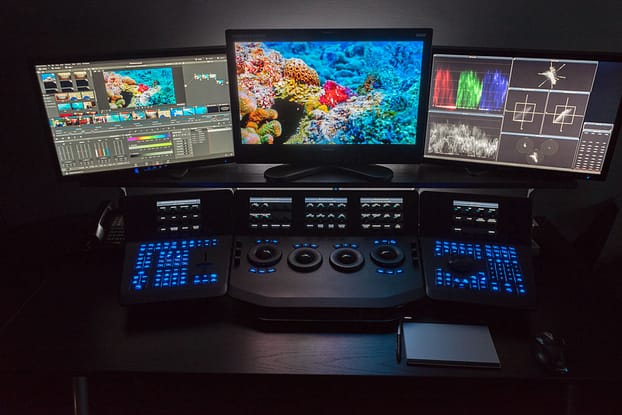Accessibility Of Color Tools Doesn’t Always Make The Decision To Work ‘In-House’ The Right One
I recently watched a webinar where the presenter pontificated that the era of projects being brought to finishing specialists like audio mixers and colorists was quickly coming to an end.
The presenter’s theory was that tools are so accessible (even free) and so powerful, that tasks once relegated for high-end suites with niche capabilities & operators were simply going to be handled by generalists probably all in one application.
Hmmmm.
There is no denying that NLE’s in particular, have become super powerful with color, VFX and audio finishing capabilities.
However, the presenter was in many ways reinforcing what many clients are thinking these days:
‘Why would I send the project out when we can do the same tasks here and probably for cheaper?
Unless you’re at the very top end of our industry, you’ve probably encountered this type of thinking.
Forget for the moment that this type of thinking (and the thinking of the presenter I listened to) is very gear/software focused and ignores talent & expertise.
Like many of you, I’ve been searching for ways to convince new & existing clients to utilize my services, even though it seems like they’ve convinced themselves that coloring and finishing in-house is the way to go.
In this Insight, I’d like to share 5 key selling points I’ve been using pretty successfully with clients who are either working in-house already or thinking about taking their work in-house.
The Appeal Of Working In-House
As Sun Tzu famously said, (paraphrasing) you need to know your enemies.
Of course, clients are not your enemies, hopefully, but they should be your long-term collaborators. In the vein of Sun Tzu, I do think it’s really important to understand why a client would want to bring their color & other finishing work in-house.

With this knowledge in place, you can better employ strategies (like the ones I’ll present below) to counter their thinking:
- Cost Savings – This reasoning shouldn’t come as a surprise. Every client wants to save money and add more to their bottom line. Most clients thinking that by investing in gear and hiring (full-time or freelance) that they’ll save money. That’s not always the case, but cost savings is the usually the number one reason for clients to move in house.
- Speed & Convenience – Having to package up projects to send out can be a pain for many clients. Posting changes, downloading files for review and even heading over to your studio for a review or supervised session can be a headache for many clients. By bringing finishing in-house, most clients believe that they’ll achieve significant workflow speed increases, and mundane tasks will become much more convenient.
- Control – Many clients crave complete control over the finishing process & sending projects out-of-house is anathema to that desire. A major reason cited by many clients who want to move work in-house is to simply have more control. Control doesn’t just apply to the overall process, it includes schedule & people too.
- Growth – With offline editorial having moved in-house in most markets well over a decade ago, the only thing going out-of-house for many production companies is final finishing (color & audio) as well as heavy VFX needs. For many clients who run small production companies, the idea of adding these services in-house represents serious growth.
Another factor that always lies under the surface between a client and service provider (you) is that there is always a give and take.
What I mean is that in many, usually non-overt ways, relationships with clients can be adversarial.
Put simply, you’re always trying to make a little more, the client is always trying to pay a little less. You’re trying to schedule a job when it’s convenient for you, they want it scheduled when it works for them.
There are a thousand other little things like this in a relationship with a client.
Talking to friends in the industry who have faced clients moving finishing in-house have had clients tell them bluntly that it’s the ‘little things’ that all add up.
Always keeping that in the back of your head and search for finding ways to avoid small pain points for a client that can go a long way to retaining work.
Next, let’s dive into the specific strategies you can use to sway clients to come or stay with you if they’re thinking about working in-house.
#1 Speed
Recently, I had a meeting with a small production company in D.C. that was doing all their color work in-house and I was trying to convince them that I could handle the work for them.
This client was producing a 13 x 30 science based broadcast series (actual program time is 24:30).
After understanding the content a client is producing, the very first question I ask is ‘how long does each show take you to color?’
‘Usually 2-3 days and then a review’ replied the potential client.
After some more questioning, I came to find out the show was being colored in Premiere Pro and the editor doing the work was all mouse and keyboard based.
Finally, after some more discussion, I came out with my what I knew would be trump card –
‘well, I can grade the show in a day, and have you in for a review the next morning’
After an incredulous look, the client responded – ‘Really? You can work that fast?’

Remember, speed is one thing that clients think bringing color work in-house helps them with.
In my experience, this is simply not true.
While every show varies, I can pretty much guarantee a client that I can grade a 24min 300-500 shot show in a day.
On this series, because it was largely interview driven I was confident I could probably do each episode in about 3/4 of a day.
Add in the efficiency that a dedicated control surface provides plus your experience grading in almost every case you’ll be able to grade faster than an in-house editor tasked with color correction duties.
In my opinion, speed and efficiency should be your number one selling point to a client who is doing work in-house.
Member Content
Sorry... the rest of this content is for members only. You'll need to login or Join Now to continue (we hope you do!).
Need more information about our memberships? Click to learn more.
Membership optionsMember Login



